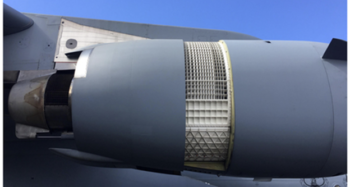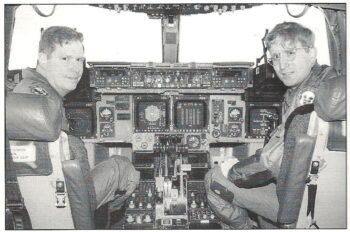In the April/May 2024 edition of ASME’s Mechanical Engineering, Lee Langston, a frequent contributing author, wrote an article1 focusing on the versatility of thrust reverser (TR) deployment applied to the mission of the four-engine C-17 Globemaster III, designed to operate into and out of short runways and austere airfields carrying large payloads. The aircraft uses a cold stream (fan flow) thrust reverser, the most common in use today, discussed in several PAI classes. Unique to the C-17 mission, the TR design provides exit area only over the upper half of their full circular circumference to avoid ingestion of dust and debris (Figure 1). Unusual for turbofan engines, the hot core exhaust flow is also reversed. The TRs provide enough thrust to reverse the aircraft while taxing backwards and create in-flight drag for maximum rate descents2. In addition to these features, Langston presents a ‘vignette’ involving ground testing done to alleviate concern over reduced fan stall margin resulting from non-uniform back pressure.

I sent the article to our own VP for Aeronautics, John Norton, who was involved in OT&E and operational leadership of the C-173. John’s response upon reviewing the article prompted me to write this news blog!
‘Some of my more memorable C-17 testing involved the TRs. I was one of the pilots on the first in-flight TR deployment—the airplane shook like crazy and we pitched down about 30 deg. I looked back at the P&W flight test engineer and asked if this is what he expected—he said yes (but he had an “I’m about to be airsick” look on his face).
We used that capability routinely in Afghanistan to “spiral down” into backed-out airfields during the first part of the war, when the combatants were still shooting at jet noise…
One of the world record flights at Edwards demonstrated extreme takeoff/landing performance with a 40K payload…takeoff and landing were each just under 1,700 ft, or less than ten airplane lengths. The TRs and brakes are really powerful, but there’s a lot to be said for reducing that V squared term in kinetic energy!’ (referring to the high-lift wing, slats, and externally blown flaps)
John also provided the photo shown in Figure 2 and shared: “The photo is of my brother and I in the cockpit of the first C-17 prototype (now in the AF Museum). Bill Norton (on the right) was a C-17 Flight Test Engineer in the same Combined Test Force as me—there was often confusion between the two Capt Nortons!”
I think we all agree that Maverick & Goose take a back seat to the Norton brothers!

1 Langston, Lee S., “C-17 Globemaster Jet Engine Thrust Reversers,” ASME Mechanical Engineering magazine, April/May 2024, pp. 50-52.
2 https://www.af.mil/About-Us/Fact-Sheets/Display/Article/1529726/c-17-globemaster-iii/
